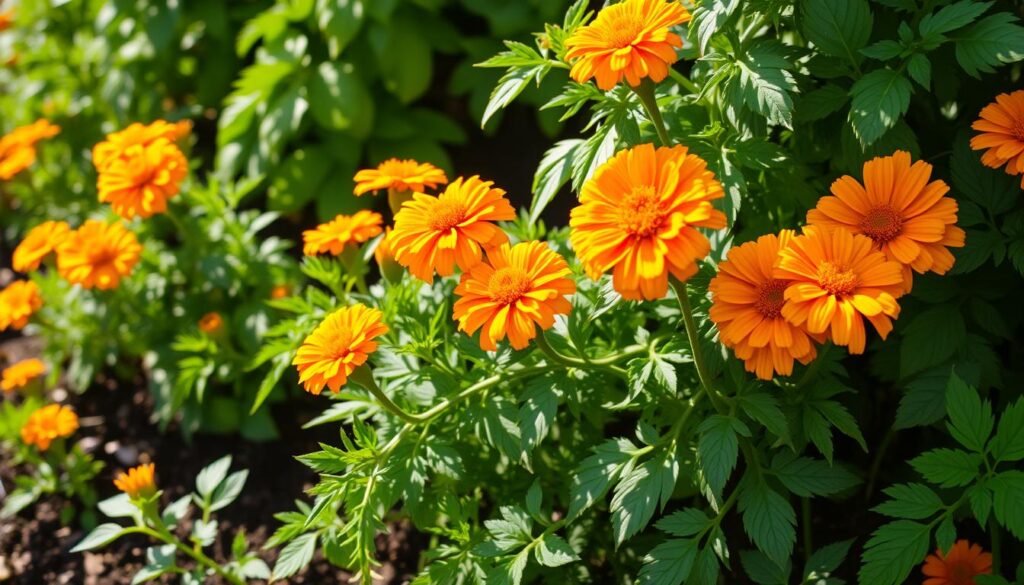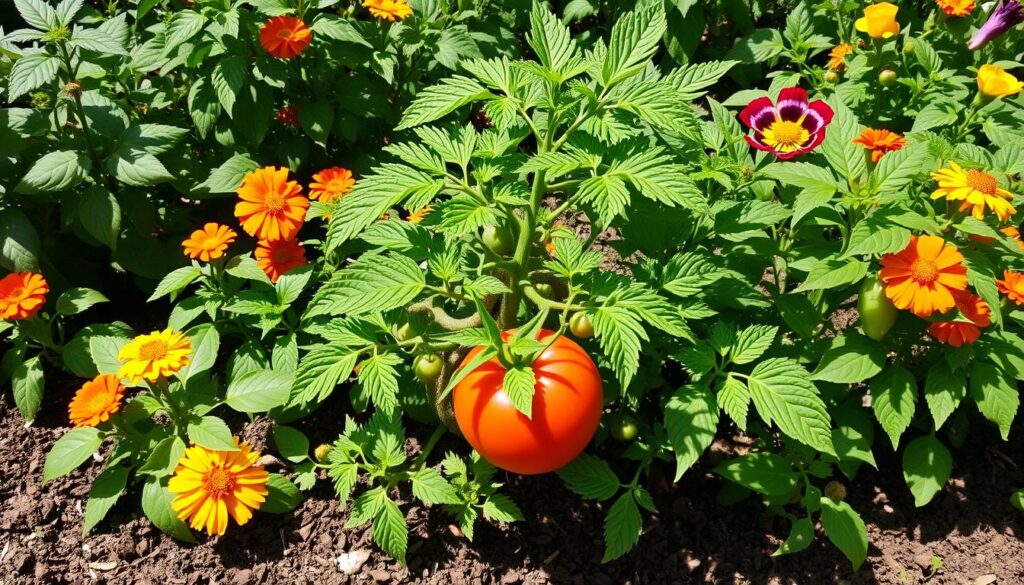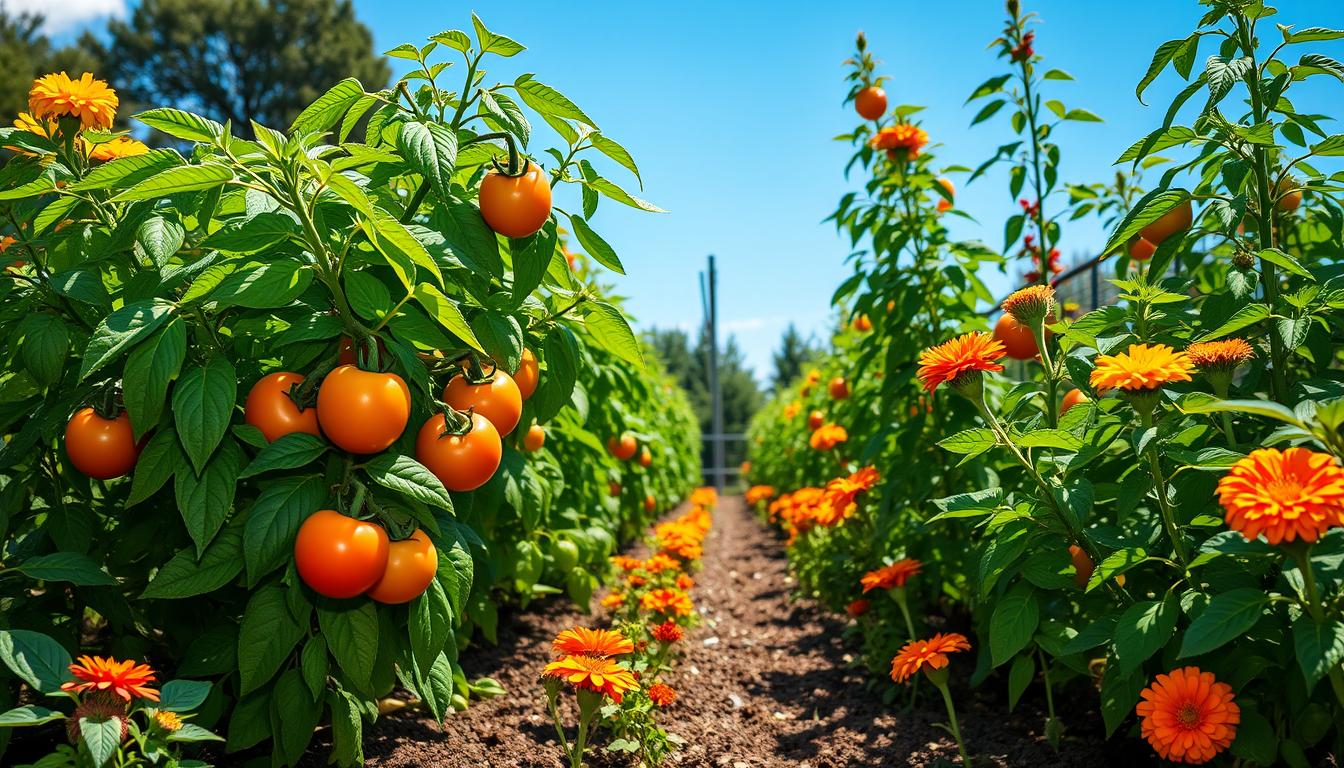Tomatoes are a favorite among gardeners. Some grow the biggest tomatoes for bragging rights. Others start seeds indoors for the earliest harvest. You can also grow cherry tomatoes and heritage varieties.
For many, tomatoes are the top crop. Planting tomatoes with companion plants is crucial. It helps them grow strong and healthy.
Key Takeaways
- Companion planting with the right plants can enhance flavor, deter pests, and improve overall tomato plant health.
- Certain herbs and flowers, like marigolds, basil, and nasturtiums, can act as natural pest repellents for tomatoes.
- Diversifying your garden through polyculture planting can maximize space and promote beneficial insect biodiversity.
- Careful consideration of plant combinations and placement is key for successful companion planting with big boy tomatoes.
- Using a variety of companion plants can provide a bountiful tomato harvest and a more sustainable, organic gardening approach.
What is Companion Planting?
Companion planting is an old gardening trick. It involves placing different plants together for their mutual benefit. This method uses natural plant relationships to boost growth, flavor, and productivity. By choosing the right plants to grow together, gardeners can improve pest control, pollination, and soil health.
Understanding the Benefits of Companion Planting
Companion planting is great for sustainable gardening. It offers many benefits, including:
- Pest Control: Some plants repel pests, protecting other crops. For instance, marigolds keep whiteflies away from tomatoes.
- Pollination: Companion plants attract bees and butterflies. This helps pollinate your main crops, increasing yields and quality.
- Soil Enrichment: Plants like beans enrich the soil with nitrogen. This reduces the need for synthetic fertilizers, making gardening more sustainable.
Types of Companion Plants for Tomatoes
There are many companion plants good for tomatoes. Some favorites are:
- Basil: Basil can keep thrips and tomato hornworms away from tomatoes.
- Marigolds: Marigolds fight whiteflies and other pests that harm tomatoes.
- Nasturtiums: These flowers attract pollinators and suppress weeds, helping tomatoes grow better.
Adding these plants to your tomato garden creates a healthy ecosystem. It boosts your tomatoes’ health and productivity.
Top Companion Plants for Big Boy Tomatoes
Choosing the right companion plants can greatly enhance your Big Boy tomatoes. Let’s look at three top picks. They offer benefits like pest control and flavor boost.
Marigolds: Insect Repellent and Pest Control
Marigolds are a gardener’s ally for growing tomatoes. Studies show they’re great at fighting whiteflies, a pest that harms tomatoes. Their scent hides the tomato plants’ smell, making it tough for pests to find them.
Basil: Enhancing Flavor and Deterring Pests
Basil is more than a tasty herb; it’s a strong ally for Big Boy tomatoes. It makes tomato roots grow bigger, leading to more fruit. Its oils also keep pests like aphids and hornworms away.
Nasturtiums: Attracting Pollinators and Weed Suppression
Nasturtiums are not just pretty; they’re also beneficial for tomatoes. They draw in bees and butterflies, helping tomatoes grow more fruit. Plus, they help keep weeds down and keep the soil moist.
Adding these three plants to your tomato garden will lead to a great harvest. Enjoy the flavors and benefits they bring to your garden.

Companion Planting: Best Plants to Grow with Big Boy Tomatoes
Companion planting is key to growing lots of Big Boy tomatoes. Pairing tomatoes with other plants makes your garden better for both your tomatoes and the garden itself.
Some top plants to grow with Big Boy tomatoes are:
- Marigolds – These bright flowers keep away pests like whiteflies and control nematodes in the soil.
- Basil – Basil keeps pests like aphids and hornworms away. It also makes your tomatoes taste better.
- Nasturtiums – These colorful flowers attract good bugs like ladybugs and lacewings. They also stop weeds around your tomatoes.
- Beans – Beans fix nitrogen in the soil, which is great for your tomato plants.
- Garlic – Garlic keeps red spider mites and late blight away, common tomato problems.
- Dill – When dill flowers, it draws in ladybugs and wasps, which fight pests.
- Carrots – Carrots loosen the soil, helping nutrients and water reach your tomatoes. They also shade your tomatoes from too much sun.
- Borage – Borage attracts bees and butterflies. It also gives nutrients to tomatoes nearby.
Adding these plants to your Big Boy tomato garden makes it a thriving ecosystem. Companion planting is a smart, eco-friendly way to improve your garden.

Polyculture Gardening: Maximizing Space and Diversity
We’re in a new era of gardening, where traditional methods are being challenged. Instead of straight rows, many now practice polyculture gardening. This approach makes our gardens more diverse and dynamic.
Benefits of Polyculture Gardening
Polyculture gardening, or intensive planting, has many benefits. It lets us grow more in less space. It also:
- Improves space use, letting us grow more in less space.
- Boosts companion planting benefits, like pest control and better pollination.
- Creates a balanced ecosystem that attracts good insects and wildlife.
- Increases garden productivity and harvests.
Implementing Polyculture in Your Garden
Starting a polyculture garden is an exciting adventure. Begin by seeing which plants grow well together. Then, learn about the needs and growth of your crops. To implement polyculture, you might use:
- Vertical gardening: Growing vining crops up using trellises or cages.
- Interplanting: Growing complementary plants close together, like greens and root veggies.
- Succession planting: Replacing old crops with new ones for ongoing harvests.
- Companion planting: Pairing plants that help each other, like tomatoes and basil.
By adopting polyculture gardening, you’ll see your garden grow in diversity and space. Get ready to enjoy the beauty of a thriving, diverse garden ecosystem.
Tips for Successful Companion Planting
Companion planting is key for growing great Big Boy tomatoes. Follow these tips for a successful harvest:
- Choose the right companion plants. Pick varieties like marigolds, basil, and nasturtiums. They help keep pests away and make tomatoes taste better.
- Pay attention to plant spacing. Make sure there’s enough room between plants. This prevents overcrowding and keeps air flowing.
- Monitor your plants closely. Watch for any signs of trouble or pests. Be ready to protect your tomatoes.
- Rotate your crops. Don’t plant tomatoes in the same spot every year. This stops diseases and pests from building up.
- Keep a garden journal. Write down what works and what doesn’t. This helps you make better choices next time.
Understanding each plant’s needs is crucial for good companion planting. Follow these tips to grow a healthy, pest-free tomato garden.
“Companion planting is a game-changer for gardeners looking to maximize their tomato yields and minimize pest problems. With the right combination of plants, you can create a symphony of flavors and a healthy, vibrant garden.”
– Niki Jabbour, author of “The Year-Round Vegetable Gardener”
Conclusion
Companion planting is a great way to make your Big Boy tomato plants healthier and more productive. By placing certain herbs, flowers, and vegetables around your tomatoes, you can attract good bugs and keep pests away. You can also improve the soil and make your tomatoes taste better.
Planting marigolds can keep nematodes away, and basil can fight off pests. These are just a few examples of how companion planting can help. It’s all about creating a balanced garden that works well together.
As you garden, try out different combinations of plants. See how they affect your Big Boy tomatoes. With a bit of creativity, you can make your garden a place of growth and abundance. Gardening is a journey, so enjoy the process and learn as you go!
Whether you’re new to gardening or have been doing it for years, companion planting can make a big difference. By using the tips from this article, you’ll be on your way to a great harvest of Big Boy tomatoes. Here’s to a successful season and the joy of enjoying your hard work!
FAQ
What is companion planting?
Companion planting is when you plant certain crops together. This helps them get more nutrients, keeps pests away, and boosts pollination. It also makes your crops grow better.
What are the benefits of companion planting for tomatoes?
Planting tomatoes with the right companions can attract good bugs and keep pests away. It also makes the soil better for your tomatoes and can even make them taste better.
What are some good companion plants to grow with Big Boy tomatoes?
Good friends for Big Boy tomatoes include marigolds, basil, nasturtiums, carrots, radishes, asparagus, parsley, borage, and chives.
How do marigolds and basil benefit tomato plants?
Marigolds keep whiteflies away. Basil makes tomatoes grow bigger and stronger. It also smells so good that it keeps pests from finding your tomatoes.
What should I avoid planting near my tomatoes?
Don’t plant tomatoes near other plants in the nightshade family. This includes eggplant and potatoes.
How can I implement companion planting in my vegetable garden?
Use plants like French marigolds or asparagus to fight pests. Plants like borage help make the soil better. Plan your garden to get the most out of companion planting.






